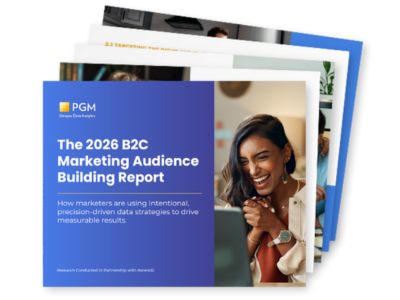Imagine you’re trying to figure out what your friends want for their birthdays.
Rather than guessing, it’s much simpler to select the right gifts if you have clues, right?
Perhaps they’ve been browsing for certain products online or talking about a specific hobby lately. It’s easier to find the perfect gift for them when you have the right insights.
That’s basically what intent data is for your business!
In this article, we’ll cover what intent data is, why it matters, and how you can leverage first-party data in your intent-based targeting strategies for effective campaigns.
What is Intent Data?
Intent data is information collected about online user behavior that indicates a user’s likely interest in a particular product or service. It’s essentially a digital footprint showing research and engagement activity related to a specific topic, problem, or solution. This data helps predict future actions, such as a purchase!
Why Intent Data Matters
There’s a saying in marketing: When you’re marketing to everyone, you’re marketing to no one.
Intent data helps you zero in on the people who matter most: The audience displaying high-intent to purchase your product.
Check out these statistics on intent data and the impact it makes on your marketing:
- More than 90% of marketers agree that intent-based strategies are useful in audience building, gaining contact-level information, creating custom triggers, integrating campaigns, and driving data source selection. (Source: ABM & Intent Benchmarking Study 2023)
- 99% of large companies are using intent data in some way. (Source: Inside Intent Data)
- Over 25% of businesses are using buyer intent data to deliver ads and campaigns to companies with a high engagement potential. (Source: DemandScience)
Leveraging First-Party Data for Your Intent-Based Targeting
Third-party cookies are indeed going away. While there have been some delays and adjustments to the timeline, the overall trend is clear: the use of third-party cookies for tracking users across websites is being phased out.
As a result, it’s important to invest in building strong direct relationships with your customers and collecting data ethically and transparently. This shift towards first-party data not only ensures more accurate and reliable intent signals but also aligns with the growing emphasis on user privacy in the digital landscape.
First-party data is important for your intent-based targeting strategy because it provides the most accurate and reliable signals directly from your customers.
Unlike third-party data, which is often aggregated, and less specific, first-party data reflects actual engagement with your brand, including website visits, purchases, email interactions, and support tickets.
This direct relationship ensures data accuracy and eliminates the potential for inaccuracies or misinterpretations that can occur with data collected from external sources.
5 Ways to Use First-Party Data for Intent-Based Targeting
1. Personalized Recommendations
Imagine you have a segment of customers who are consistently browsing running shoes on your e-commerce site, comparing different brands and models. This strong first-party intent signal indicates a high likelihood of purchase.
Intent Data Tip: Using intent data, show them targeted ads or email recommendations for running shoes, related accessories (socks, insoles), or running apparel. This might involve showing them dynamic product ads featuring the specific running shoes they viewed, sending personalized email recommendations for similar shoes or related accessories like running socks and insoles, or even offering exclusive bundles or discounts on running apparel.
2. Abandoned Cart Recovery
One of the most effective uses of first-party intent data is recovering abandoned carts. When a customer adds items to their online shopping cart but leaves without completing the purchase, it signifies a near-purchase intent. This is a low-hanging fruit for your intent-based targeting strategy.
Intent Data Tip: Track this behavior to trigger automated email reminders. These emails can include a summary of the abandoned items, a gentle nudge to complete the purchase, and potentially an incentive like a small discount or free shipping to overcome any hesitation. This targeted approach directly addresses the customer’s almost-purchase and can significantly boost sales recovery.
3. Content Personalization
When a customer downloads a specific piece of content from your website, such as a “Beginner’s Guide to Gardening,” they’re clearly expressing interest in that topic. This action signals to you that this customer wants more information about gardening and is a valuable opportunity to reach them with personalized messaging.
Intent Data Tip: Send targeted follow-up emails containing related blog posts, videos, or product recommendations. For the gardening enthusiast, this could include articles on specific plant care, recommendations for gardening tools or seeds, or even promotions on related products like fertilizers or potting soil. Sending this relevant content strengthens engagement and positions your brand as a helpful resource.
4. Targeted Promotions
Analyzing purchase history and browsing behavior can reveal valuable insights into your customers’ preferences. For example, if you have customers who are consistently purchasing organic and eco-friendly products, this first-party data signals a strong affinity for sustainability.
Intent Data Tip: Offer exclusive discounts on new eco-friendly product lines, provide early access to sustainable initiatives, or even partner with environmental organizations for co-branded campaigns. This demonstrates that you understand values and reinforces their connection with your brand.
5. Improved Customer Service
First-party data related to customer service interactions can significantly enhance the support experience. For example, if a customer frequently contacts support for technical assistance with a specific product, it indicates a potential pain point.
Intent Data Tip: Track these interactions to proactively offer helpful resources like tutorials, FAQs, or troubleshooting guides related to those common issues. This proactive approach not only reduces the need for repeated support requests but also builds trust and demonstrates your commitment to customer satisfaction.



